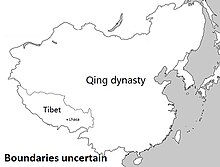Tibet di bawah pemerintahan Qing
| Tibet di bawah pemerintahan Qing | |||||||||
|---|---|---|---|---|---|---|---|---|---|
| di bawah pemerintahan di Dinasti Qing | |||||||||
| 1720–1912 | |||||||||
 Tibet dalam Dinasti Qing pada 1820. | |||||||||
| Ibu kota | Lhasa | ||||||||
| History | |||||||||
| • Jenis | Hierarki Qing dan Kashag | ||||||||
| Sejarah | |||||||||
| 1720 | |||||||||
| 1912 | |||||||||
| |||||||||
Tibet di bawah pemerintahan Qing[1][2] merujuk kepada hubungan dinasti Qing dengan Tibet dari 1720 hingga 1912.[3][4][5] Dalam tempoh ini, Qing China menganggap Tibet sebagai sebuah negara vasal.[6] Tibet menganggap diri sendiri sebuah negara merdeka yang hanya mempunyai hubungan "pendeta dan penaung" dengan Dinasti Qing.[7][8][9][10] Ulama seperti Melvyn Goldstein telah menganggap Tibet sebagai negeri naungan Qing.[11]
Rujukan[sunting | sunting sumber]
- ^ Dabringhaus, Sabine (2014), "The Ambans of Tibet—Imperial Rule at the Inner Asian Periphery", dalam Dabringhaus, Sabine; Duindam, Jeroen (penyunting), The Dynastic Centre and the Provinces, Agents and Interactions, Brill, m/s. 114–126, doi:10.1163/9789004272095_008, ISBN 9789004272095, JSTOR 10.1163/j.ctt1w8h2x3.12
- ^ Di Cosmo, Nicola (2009), "The Qing and Inner Asia: 1636–1800", dalam Nicola Di Cosmo; Allen J. Frank; Peter B. Golden (penyunting), The Cambridge History of Inner Asia: The Chinggisid Age, Cambridge University Press
- ^ Szczepanski, Kallie (31 May 2018). "Was Tibet Always Part of China?". ThoughtCo.
- ^ Lamb 1989: "From the outset, it became apparent that a major problem lay in the nature of Tibet's international status.
- ^ Sperling 2004: "The status of Tibet is at the core of the dispute, as it has been for all parties drawn into it over the past century.
- ^ Sperling 2004.
- ^ Mehra 1974: The statement of Tibetan claims at the 1914 Simla Conference read: "Tibet and China have never been under each other and will never associate with each other in future.
- ^ Szczepanski, Kallie (31 May 2018). "Was Tibet Always Part of China?". ThoughtCo.
- ^ Tsering Shakya, "The Thirteenth Dalai Lama, Tubten Gyatso" Treasury of Lives, accessed May 11, 2021.
- ^ Fitzherbert & Travers 2020: '[From 1642], as a Buddhist government, the Ganden Phodrang’s choice to relinquish... the military defence of its territory to foreign troops, first Mongol and later Sino-Manchu, in the framework of “patron-preceptor” (mchod yon) relationships, created a structural situation involving long-term contacts and cooperation between Tibetans and "foreign" military cultures.'
- ^ Goldstein, Melvyn C. (April 1995), Tibet, China and the United States (PDF), The Atlantic Council
Bibliografi[sunting | sunting sumber]
- Tibet, Proving Truth from Facts, Department of Information and International Relations, Central Tibetan Administration, 1994
- Tibet: Proving Truth from Facts, Central Tibetan Administration, 1 January 1996.
- Fitzherbert, Solomon George; Travers, Alice (2020), "Introduction: The Ganden Phodrang's Military Institutions and Culture between the 17th and the 20th Centu-ries, at a Crossroads of Influences", Revue d'Etudes Tibétaines, CNRS, 53: 7–28
- Lamb, Alastair (1989), Tibet, China & India, 1914-1950: A history of imperial diplomacy, Roxford Books, ISBN 9780907129035
- Mehra, Parshotam (1974), The McMahon Line and After: A Study of the Triangular Contest on India's North-eastern Frontier Between Britain, China and Tibet, 1904-47, Macmillan, ISBN 9780333157374 – melalui archive.org
- Norbu, Dawa (2001), China's Tibet Policy, Routledge, ISBN 978-1-136-79793-4
- Smith, Warren (1996), Tibetan Nation: A History of Tibetan Nationalism And Sino-Tibetan Relations, Avalon Publishing, ISBN 978-0-8133-3155-3
- Sperling, Elliot (2004), The Tibet-China Conflict: History and Polemics (PDF), East-West Center Washington, ISBN 978-1-932728-12-5
